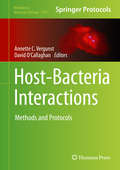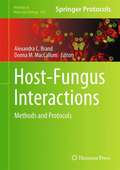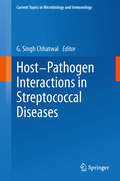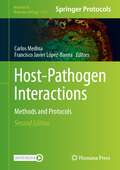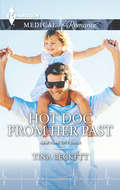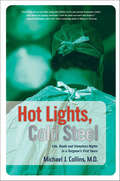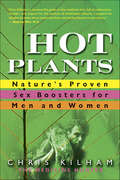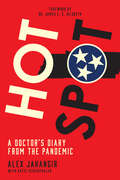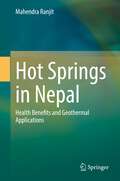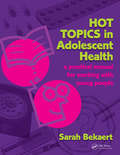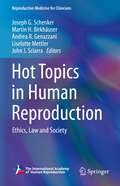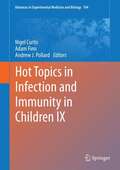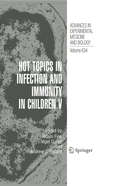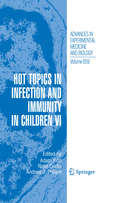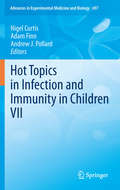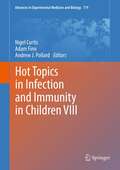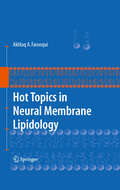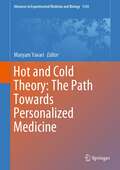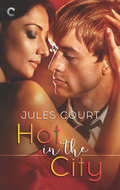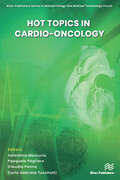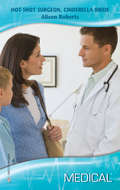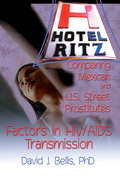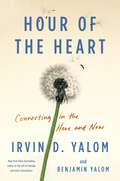- Table View
- List View
Host-Bacteria Interactions
by Annette C. Vergunst David O'CallaghanHost-Bacteria Interactions: Methods and Protocols details cutting edge protocols that cover aspects of the investigation of host bacteria interactions using mammalian and novel non mammalian infection models, cell biology, OMICS and bacterial genetics. Chapters focus on techniques that can be used to investigate different aspects of the physiopathology of bacterial infections, from the whole animal to tissue, cellular and molecular level. Written in the highly successful Methods in Molecular Biology series format, chapters include introductions to their respective topics, lists of the necessary materials and reagents, step-by-step, readily reproducible laboratory protocols and tips on troubleshooting and avoiding known pitfalls. Authoritative and cutting-edge, Host-Bacteria Interactions: Methods and Protocols provide researchers with a comprehensive account of the practical steps necessary for carrying out each protocol successfully.
Host-Fungus Interactions: Methods and Protocols (Methods in Molecular Biology #845)
by Donna M. Maccallum Alexandra C. BrandMicrobiologists, medical mycologists, immunologists, and biochemists are increasingly working together to focus on the processes involved in the progression and treatment of fungal disease. Host-Fungus Interactions: Methods and Protocols is designed for research scientists who are involved in this work and interested in undertaking new or comparative studies of interactions between the mammalian host and clinically important fungal pathogens. Aiming to combine approaches for reverse genetics in pathogenic fungi with methods for their application in in vitro and in vivo models of disease, the book includes methods for the culture and genetic manipulation of the primary fungal pathogens and the opportunistic pathogens, as well as methods for investigating host-fungus interactions in model systems. Written in the highly successful Methods in Molecular BiologyTM series format, chapters include introductions to their respective topics, lists of the necessary materials and reagents, step-by-step, readily reproducible laboratory protocols, and tips on troubleshooting and avoiding known pitfalls. Comprehensive and practical, Host-Fungus Interactions: Methods and Protocols describes available molecular methods and fungal infection models in great detail in order to encourage researchers to try new approaches to investigating host-fungus interactions with added levels of confidence.
Host-Pathogen Interactions
by Kai Sohn Steffen RuppIn recent decades, infectious diseases, once believed to be fairly contained, have become a vital, resurgent field of research. In Host-Pathogen Interactions: Methods and Protocols, top experts examine the relationship between the host and the pathogen, crucial in the outcome of an infection and the establishment of disease or asymptomatic, commensal colonization by organisms. The step-by-step laboratory methods and protocols of this volume study host-pathogen interaction, with a focus on fungal, bacterial and parasitic pathogens, at a molecular level in order to reveal the mechanisms of infection and to identify the vulnerabilities of the pathogen of interest. Written in the highly successful Methods in Molecular BiologyTM series format, the chapters feature brief subject introductions, lists of the necessary materials and reagents, and tips on troubleshooting and avoiding known pitfalls. Comprehensive and cutting-edge, Host-Pathogen Interactions: Methods and Protocols serves as an easy entry point for all those investigating the factors responsible for the pathogenicity of microorganisms.
Host-Pathogen Interactions in Streptococcal Diseases
by G Singh ChhatwalStreptococci are Gram-positive bacteria that cause a wide spectrum of diseases, such as pharyngitis, necrotizing fasciitis and streptococcal toxic shock syndrome, as well as rheumatic fever and rheumatic heart disease as sequelae. Antibiotics alone have not been able to control the disease and in spite of many efforts an effective vaccine is not yet available. A prerequisite for novel and successful strategies for combating these bacteria is a complete understanding of the highly complex pathogenic mechanisms involved, which are analyzed in this volume. In ten chapters, prominent authors cover various aspects including streptococcal diseases and global burden, epidemiology, adaptation and transmission, and molecular mechanisms of different diseases, as well as sequelae, vaccine development and clinical management. This book will serve as a valuable reference work for scientists, students, clinicians and public health workers and provide new approaches to meeting the challenge of streptococcal diseases.
Host-Pathogen Interactions: Methods and Protocols (Methods in Molecular Biology #2751)
by Carlos Medina Francisco Javier López-BaenaThis fully updated volume serves as multidisciplinary compendium of approaches and techniques employed to analyze the role of different molecules, processes, or strategies used by different guests to survive and proliferate in their associations with eukaryotic hosts. Beginning with animal-pathogen interactions, the book then continues with chapters exploring virus-host interactions, plant-microbe interactions, as well as different molecular techniques that were initially applied to non-pathogenic interactions but can be adapted to study other host-pathogen associations. Written for the highly successful Methods in Molecular Biology series, chapters include introductions to their respective topics, lists of the necessary materials and reagents, step-by-step and readily reproducible laboratory protocols, as well as tips for troubleshooting and avoiding known pitfalls.Authoritative and up-to-date, Host-Pathogen Interactions: Methods and Protocols, Second Edition contributes to the study of host-pathogen interactions with numerous techniques that can be used in a variety of bacteria.
Hot Doc from Her Past
by Tina BeckettA smile she can never forget! Stepping into West Manhattan Saints, Dr. Tessa Camara is stunned to discover the hospital's new orthopedic surgeon is Dr. Clay Matthews-her ex! Four years apart has done nothing to extinguish the fire between them, but she has never forgiven Clay for his betrayal... Clay still doesn't know why Tessa ended their relationship. And with his adorable little daughter, Molly, to consider, he doesn't have time for Tessa's independence issues. But resisting the passionate Brazilian woman who once stole his heart is easier said than done!
Hot Lights, Cold Steel: Life, Death and Sleepless Nights in a Surgeon's First Years
by Michael J. Collins“An orthopedic surgeon’s down-to-earth, fast-paced, and frequently funny memoir of his residency [told] with a born storyteller’s skill.” —Kirkus ReviewsMichael Collins’ account of his four-year surgical residency at the famed Mayo Clinic traces his rise from an eager but clueless first-year resident navigating chaos and feelings of inadequacy to accomplished Chief Resident in his final year. With unparalleled humor, he recounts the disparity between people’s perceptions of a doctor’s glamorous life and the real thing: a succession of rundown cars towed to the junk yard, long weekends moonlighting at rural hospitals, a family that grows larger every year, and a laughable income. Collins’ good nature helps him over some of the rough spots—but cannot spare him the harsh realities and heart-wrenching decisions of a doctor’s life. A teenager’s leg is mangled by a tractor: risk the boy’s life to save his leg, or amputate immediately? A woman diagnosed with bone cancer injures her hip: should he recommend a painful operation even though she has only months to live? Unflinching and deeply engaging, Hot Lights, Cold Steel captures the author’s struggles to reconcile his idealism and desire to heal with the recognition of his own limitations and imperfections.“Collins’ life as a surgical resident is heartbreaking one minute and triumphant the next. You’ll laugh and cry and cheer.” —Augusten Burroughs, New York Times–bestselling author of Dry“At once darkly humorous and truly compassionate. Not since House of God has there been such a ferociously funny look at the world of hospital medicine.” —Michael Palmer, New York Times–bestselling author of The Last Surgeon“I adore this book.” —Tess Gerritsen, New York Times–bestselling author of the Rizzoli & Isles novels
Hot Nights with the Arctic Doc (Valentine Flings)
by Luana DaRosaIn this first installment of the Valentine Flings duet, a GP travels to Svalbard and is soon swept into a steamy fling with her new boss… LOVE IN A COLD CLIMATE? GP Larissa has escaped to the Arctic island of Svalbard for a work opportunity. Desperate to forget the disappointments of losing her job and a failed romance, her irresistible draw to doctor Erik Fjell, her sexy new boss, could be the perfect distraction! Erik finds Larissa tempting, too, but he&’s learned the hard way that his duty to the remote Norwegian community doesn&’t gel with happy-ever-after. And with Larissa&’s placement ending soon, they could never have anything more than short-term…could they?From Harlequin Medical: Life and love in the world of modern medicine. Valentine FlingsBook 1: Hot Nights with the Arctic Doc by Luana DaRosaBook 2: Nurse's Keralan Temptation by Becky Wicks
Hot Plants: Nature's Proven Sex Boosters for Men and Women
by Chris KilhamIn the wake of Viagra's enormous popularity, the international market has been inundated by a blizzard of purported natural sex enhancers. Some of these products are nothing but hype, yet others contain proven agents that enhance libido, improve sexual function, and increase pleasure. These bona fide sex-boosters can be found in Hot Plants.From the ancient rainforests of Malaysia, to remote mountains in Siberia, medicine hunter Chris Kilham has scoured the globe in search of effective, sex-enhancing plants. Hot Plants, Nature's Proven Sex Boosters For Men And Women, contains a lively account of those adventurous travels, with valuable information that you can use to boost your sex life. These natural agents of desire include Tongkat Ali, maca, yohimbe, catuaba, ashwagandha, horny goat weed, zallouh root, Rhodiola rosea, Red ginseng, Siberian ginseng and chocolate. Medicine Hunter Chris Kilham draws upon history, legend and keen research, as he weaves tales of remarkable people, exotic locations, and his extensive investigations into the science and uses of the hot plants. Learn which plants increase libido in both men and women, improve erectile function in men, put more fire into your sex life, and significantly boost your pleasure.
Hot Spot: A Doctor's Diary From the Pandemic
by Dr. Alex JahangirWhen Nashville identified its first case of coronavirus in March 2020, the city was between Public Health Department directors and as unprepared as the rest of the world for what was to come. Dr. Alex Jahangir, a trauma surgeon acting at that time as chair of the Metro Nashville Board of Health, unexpectedly found himself head of the city's COVID-19 Task Force and responsible for leading it through uncharted waters. What followed was a year of unprecedented challenge and scrutiny. Jahangir, who immigrated to the US from Iran at age six, grew up in Nashville. He thought he knew the city well. But the pandemic laid bare ethnic, racial, and cultural tensions that daily threatened to derail what should have been a collective effort to keep residents healthy and safe.Hot Spot is Jahangir's narrative of the first year of COVID, derived from his op notes (the journal-like entries surgeons often keep following operations) and expanded to include his personal reflections and a glimpse into the inner sanctums of city and state governance in crisis.
Hot Springs in Nepal: Health Benefits and Geothermal Applications
by Mahendra RanjitThis book presents a profile of the majority of hot springs in and around tourist destinations in Nepal. In particular, there is a focus on Pokhara, Jumla, the world- famous Annapurna region, Ruby Valley, and Api Nampa Conservation Area. The chapter on health benefits of mineral hot springs provides a history of hot springs supported by a literature review and case study. Further chapters explore the direct uses of geothermal energy for various purposes and power generation, together with a section on conventional hydrothermal resources. This book is of interest to the general public, students, national and international researchers, energy planners, and health professionals. The book is a valuable tool for sociologists who want to gain insight into the cultural and religious aspects of hot water mineral springs.
Hot Topics in Adolescent Health: A Practical Manual for Working with Young People
by Sarah Bekaert Dame Lesley SouthgateWhat do young people need to know about their health - and how can you help them learn it? This practical guide will help you to broach health subjects (ranging from the banal to the embarrassing to the deadly serious) with the adolescents you encounter in your professional life. Drawing on research and collaboration with specialists in areas such as dietetics, mental health, drugs and alcohol, fitness, education and careers, along with young people themselves, Hot Topics in Adolescent Health provides a range of support mechanisms for professionals working with young people. Using interactive methods of delivery, this practical guide and complimentary CD provide figures, diagrams and suggested activities to explore each topic within a group setting and point to other resources for further information. The book covers both the basic and more detailed issues beginning with an introduction to adolescence and puberty before exploring key issues such as body image, diet and exercise, mental health, drugs, alcohol, relationships and sex (including contraception, sexual health, pregnancy and abortion) - giving lots of inspiration on how to confidently answer those tricky questions. Sections on consent and confidentiality when working with young people, as well as a vital summary of child protection policy and procedure, will also prove useful. It is highly recommended for healthcare professionals, teachers, therapists, counsellors, community group leaders and all people working with adolescents.
Hot Topics in Human Reproduction: Ethics, Law and Society (Reproductive Medicine for Clinicians #3)
by Andrea R. Genazzani Liselotte Mettler Joseph G. Schenker John J. Sciarra Martin H. BirkhaeuserThis new volume in the Reproductive Medicine for Clinicians series of the International Academy of Human Reproduction (IAHR) focuses on current hot topics in the field, their ethical and legal aspects and their impact on society.It covers topics such as Covid-19, religious and philosophical controversies, possibilities that new technologies offer, human reproductive cloning problems, future challenges related to the heritable gene editing, therapeutic use of stem cells and stem cell factors and the role of receptors in steroids hormone action.This volume also offers an analysis of important innovations and new possibilities such as the use of artificial intelligence in reproductive medicine and the future of prenatal testing. The volume also discusses the issues of pregnancies in advanced paternal age, ethical and legal aspects of gametes donation, sex preselection, surrogate motherhood and infertility in overweight or obese PCOS patients. Chapters on the ethical and legal aspects of fertility preservation in woman, in children with cancer, and in patients sparing treatments in gynecological oncology are also included. This new volume in the series is a valuable resource for gynecologists, obstetricians, endocrinologists, general practitioners and all specialists dealing with reproductive health.
Hot Topics in Infection and Immunity in Children IX (Advances in Experimental Medicine and Biology #764)
by Nigel Curtis Andrew J. Pollard Adam FinnCourse covers topics in infectious diseases in children and is intended for Pediatric Infectious disease trainees, trainers, and all those who manage children with infections. This conference is being supported by several societies and is sponsored by several pharmaceutical companies, such as Aventis, Baxter, Chiron Vaccines, Wyeth, etc.
Hot Topics in Infection and Immunity in Children V
by Nigel Curtis Andrew J. Pollard Adam FinnCourse covers topics in infectious diseases in children and is intended for Pediatric Infectious disease trainees, trainers, and all those who manage children with infections. This conference is being supported by several societies and is sponsored by several pharmaceutical companies, such as Aventis, Baxter, Chiron Vaccines, Wyeth, etc.
Hot Topics in Infection and Immunity in Children VI
by Nigel Curtis Andrew J. Pollard Adam FinnCourse covers topics in infectious diseases in children and is intended for Pediatric Infectious disease trainees, trainers, and all those who manage children with infections. This conference is being supported by several societies and is sponsored by several pharmaceutical companies, such as Aventis, Baxter, Chiron Vaccines, Wyeth, etc.
Hot Topics in Infection and Immunity in Children VII
by Nigel Curtis Andrew J. Pollard Adam FinnCourse covers topics in infectious diseases in children and is intended for Pediatric Infectious disease trainees, trainers, and all those who manage children with infections. This conference is being supported by several societies and is sponsored by several pharmaceutical companies, such as Aventis, Baxter, Chiron Vaccines, Wyeth, etc.
Hot Topics in Infection and Immunity in Children VIII
by Nigel Curtis Andrew J. Pollard Adam FinnBook covers course with topics in infectious diseases in children and is intended for Pediatric Infectious disease clinical researchers, trainees, trainers, and all those who manage the research of children with infections and the children themselves. The conference is being supported by several societies and is sponsored by several pharmaceutical companies, such as Aventis, Baxter, Chiron Vaccines, Wyeth, etc. ToC reflects the scientific program found here: http://www.oxfordiic.org/#course
Hot Topics in Neural Membrane Lipidology
by Akhlaq A. FarooquiGlycerophospholipid and sphingolipid-derived lipid mediators facilitate the transfer of messages not only from one cell to another but also from one subcellular organelle to another. These molecules are not only components of neural membranes but also storage depots for lipid mediators. Information on the generation and involvement of lipid mediators in neurological disorders is scattered throughout the literature in the form of original papers and reviews. This book will provide readers with a comprehensive description of glycerophospholipid, sphingolipid and cholesterol-derived lipid mediators and their involvement in neurological disorders.
Hot and Cold Theory: The Path Towards Personalized Medicine (Advances in Experimental Medicine and Biology #1343)
by Maryam YavariThis book is about the theory of Hot and Cold, a mutual fundamental base of traditional medicines all around the world. The theory describes the dynamic balance state of the body on the axis of hot and cold for each individual and proposes the fact that deviation from this equilibrium is a predisposing factor for diseases. Such an approach helps practitioners to provide treatments tailored to the patient’s condition, not the disease. This book, for the first time, has gathered native descriptions of Hot and Cold theory in different traditional medicines, including traditional Chinese medicine, Persian (Humoral, Unani) medicine, Ayurvedic medicine and Latin American and Caribbean medicines. After defining the common ground, contemporary research - in nutrition, pharmacology, physiology and systems biology - has been explored using scientific methodology. This work is the result of an international collaboration of more than 30 scientists and scholars with high reputations in their fields. Hot and Cold theory, as a holistic individualized approach in prevention, diagnosis and treatment, can be merged into the novel fast-paced concepts in systems biology and precision medicine. Through this bridge, the authors propose that the Hot and Cold theory should be revisited more deeply by medical scientists, who are the main audience of this book, to pave the way towards integrated holistic personalized medicine.
Hot in the City
by Jules CourtThe first time Detective Brian MacGregor met Priya Shah, he was bleeding. Injured apprehending a suspect, he just needed a few stitches. He didn't expect to feel a gut punch of lust for the beautiful ER doc. But another emergency called her away before he had a chance to ask her out...or kiss her. Or find out if she shared his sudden sex-in-a-dark-hospital-room fantasy. The second time he met Priya, she was protecting a murder witness. Protecting is putting it strongly, if you ask Priya. Her cousin may have witnessed a murder, but she had nothing to do with it. Even if the hot ginger cop seems like the perfect solution to Priya's summer dry spell, they both have more important things to worry about. Like finding Sara before the murderer does. As far as Brian's concerned, Priya is the key-her cousin is bound to come back to her eventually, and when she does, he'll be there. They just need to keep their hands off each other until then. But when attraction burns this hot, it's only so long before someone has to break... This book is approximately 35,000 words One-click with confidence. This title is part of the Carina Press Romance Promise: all the romance you're looking for with an HEA/HFN. It's a promise! Find out more at CarinaPress.com/RomancePromise
Hot topics in Cardio-Oncology (River Publishers Series In Biotechnology And Medical Technology Forum Ser.)
by Valentina Mercurio; Pasquale Pagliaro; Claudia Penna; Carlo Gabriele TocchettiOver the last years, thanks to growing advances in the field of cancer therapies, a considerable decrease in cancer mortality has been observed. Unfortunately, such therapies have shown a wide spectrum of cardiotoxicities. This book provides the readers with the latest advances and insights in the ever-expanding field of Cardio-Oncology. Specific topics discussed in the book include the potential role of inflammation in Cardio-Oncology and the description of the different manifestations of cardiotoxicities (including vascular toxicity, systemic hypertension, arrhythmias), analyzing the complex relationships between cancer and heart failure, two conditions whose prevalence increases with ageing. Furthermore, the role of biomarkers and imaging in cardio-oncology is discussed.
Hot-Shot Surgeon, Cinderella Bride
by Alison RobertsWhen Kelly dances with gorgeous Tony Grimshaw at a lavish masquerade ball, she's swept away in the fantasy of the moment. Her beautiful borrowed gown, the sizzling attraction in the air and the touch of his hands make her feel like a princess! But come morning Kelly is left with only memories. In her nurse-orderly uniform, she knows she's invisible to the likes of wealthy top-notch surgeon Tony. All her life Kelly's dreams have been just out of reach. Little does she realize that the dashing surgeon is searching for his real-life Cinderella. . . .
Hotel Ritz - Comparing Mexican and U.S. Street Prostitutes: Factors in HIV/AIDS Transmission
by R Dennis Shelby David J BellisExplore ways to reduce the rate of HIV infection in street prostitutes--and the inescapable connection between the heroin trade, prostitution, and HIV!This unique book draws on face-to-face interviews that the author conducted on the streets, with heroin-addicted street prostitutes in Southern California and their counterparts in four large Mexican cities. Author David James Bellis illustrates the significant--and surprising--differences in the risk of exposure to HIV and other STDs that exist between street prostitutes in the two countries arising from national differences in the legality, sociology, and economics of sex work. He points out that Mexican prostitutes, for whom sex work is a simple means of livelihood, are “choir girls” compared with their beaten-up, drug-addicted sisters north of the border who perform sex for drug money and are at much greater risk of HIV and other diseases, like Hepatitis C. This book explores those differences, suggesting new directions for United States prostitution and heroin-control policies--laws currently so interwoven that they reinforce each other, accounting for a deadly circle of crime and disease. In addition to the fascinating results of the author's interviews with 72 female street prostitutes in San Bernardino, California, and 102 more in Tijuana, Cd. Juárez, Cd. Victória, and Cuernavaca regarding their personal sexual, drug, and health practices, and their criminal histories, Hotel Ritz-Comparing Mexican and U.S. Street Prostitutes: Factors in HIV/AIDS Transmission explores: the licensing process for legal prostitutes in Mexico the medical testing that Mexico requires prostitutes to undergo the differences in what United States and Mexican prostitutes know about HIV transmission the difference in condom use between United States and Mexican prostitutes the potential benefits of reforming prostitution and drug laws in both countries the benefits of making methadone maintenence and syringes-and heroin-free for heroin-addicted prostitutes the proportion of United States/Mexican prostitutes who would quit the trade if they learned they had AIDS how the social support system in the United States (housing subsidies, TANF/AFDC money, food stamps, etc.) leads to a greater proportion of drug-addicted prostitutes than are found in Mexico Hotel Ritz-Comparing Mexican and U.S. Street Prostitutes: Factors in HIV/AIDS Transmission also provides you with a look at the hierarchy of female sex workers, an explanation of the etiology of AIDS transmission, and a concise history of heroin and prostitution. Helpful tables and an appendix containing the author's survey questions make the data in this well-referenced book easily understandable.
Hour of the Heart: Connecting in the Here and Now
by Irvin D. Yalom Benjamin YalomA deeply moving and revealing chronicle of the challenges and breakthroughs that come from a wholly new practice of one-hour, one-time-only sessions, from one of the most prominent psychotherapists of our timeFacing memory loss at age ninety-three as well as the fallout from a global pandemic that moved much of daily life online, legendary psychotherapist and bestselling author Irvin D. Yalom was forced to vastly reconsider the shape of his sessions with patients. Rather than throw in the towel in the face of change, Dr. Yalom considered head-on the limitations imposed by these new realities and revolutionized his practice. Turning his focus to what might be achieved in a one-hour, one-time-only meeting between patient and practitioner, Dr. Yalom employed an even more concerted use of his “here and now” approach.In Hour of the Heart, Yalom recounts some of these intense, life-changing sessions, exploring an array of human predicaments and his own late-career development as a therapist. In recounting these consultations, he shows how a therapist’s willingness to be open helps patients let down their own guards, leading to a deeper and more immediate connection—one necessary to achieving profound realizations in just sixty minutes. This vulnerability led Yalom to disclose details about his personal life that he might previously have kept hidden from patients, including his traumatic childhood in Washington, DC, the evolution of his thinking about philosophy and psychotherapy, and the recent death of his wife. Throughout, he pushes the boundaries of self-revelation as a therapeutic tool.Life is precious and our time together short. Written in collaboration with his son, Hour of the Heart shows us how to relate to each other better in the moment, with more honesty and vulnerability. That hour of connection, occurring during a time of isolation and grief for so many, helped to sustain both patient and therapist, and enriched Yalom’s vision of what psychotherapy can do.
